Staged Joint Arthrodesis in the Treatment of Severe Septic Ankle Arthritis Sequelae: A Case Report
Abstract
1. Introduction
2. Case Presentation
3. Discussion
4. Conclusions
Author Contributions
Funding
Institutional Review Board Statement
Informed Consent Statement
Conflicts of Interest
Abbreviations
| CT | computed tomography |
| SPECT | single-photon emission computed tomography |
| WBC | white blood cell |
References
- Newman, J.H. Review of septic arthritis throughout the antibiotic era. Ann. Rheum. Dis. 1976, 35, 198–205. [Google Scholar] [CrossRef]
- Esterhai, J.L., Jr.; Gelb, I. Adult septic arthritis. Orthop. Clin. N. Am. 1991, 22, 503–514. [Google Scholar] [CrossRef]
- Stutz, G.; Kuster, M.S.; Kleinstück, F.; Gächter, A. Arthroscopic management of septic arthritis: Stages of infection and results. Knee Surg. Sports Traumatol. Arthrosc. 2000, 8, 270–274. [Google Scholar] [CrossRef]
- Vispo Seara, J.L.; Barthel, T.; Schmitz, H.; Eulert, J. Arthroscopic treatment of septic joints: Prognostic factors. Arch. Orthop. Trauma Surg. 2002, 122, 204–211. [Google Scholar] [CrossRef] [PubMed]
- Kang, S.N.; Sanghera, T.; Mangwani, J.; Paterson, J.M.; Ramachandran, M. The management of septic arthritis in children: Systematic review of the English language literature. J. Bone Joint Surg. Br. 2009, 91, 1127–1133. [Google Scholar] [CrossRef] [PubMed]
- Mathews, C.J.; Weston, V.C.; Jones, A.; Field, M.; Coakley, G. Bacterial septic arthritis in adults. Lancet 2010, 375, 846–855. [Google Scholar] [CrossRef]
- Klouche, S.; El-Masri, F.; Graff, W.; Mamoudy, P. Arthrodesis with internal fixation of the infected ankle. J. Foot Ankle Surg. 2011, 50, 25–30. [Google Scholar] [CrossRef] [PubMed]
- Movassaghi, K.; Wakefield, C.; Bohl, D.D.; Lee, S.; Lin, J.; Holmes, G.B.J.; Hamid, K.S. Septic Arthritis of the Native Ankle. JBJS Rev. 2019, 7, e6. [Google Scholar] [CrossRef]
- Hogan, A.; Heppert, V.G.; Suda, A.J. Osteomyelitis. Arch. Orthop. Trauma Surg. 2013, 133, 1183–1196. [Google Scholar] [CrossRef]
- Holtom, P.D.; Borges, L.; Zalavras, C.G. Hematogenous septic ankle arthritis. Clin. Orthop. Relat. Res. 2008, 466, 1388–1391. [Google Scholar] [CrossRef]
- Mankovecky, M.R.; Roukis, T.S. Arthroscopic synovectomy, irrigation, and debridement for treatment of septic ankle arthrosis: A systematic review and case series. J. Foot Ankle Surg. 2014, 53, 615–619. [Google Scholar] [CrossRef]
- Kazemi, K.; Arab, A.M.; Abdollahi, I.; López-López, D.; Calvo-Lobo, C. Electromiography comparison of distal and proximal lower limb muscle activity patterns during external perturbation in subjects with and without functional ankle instability. Hum. Mov. Sci. 2017, 55, 211–220. [Google Scholar] [CrossRef] [PubMed]
- Casado-Hernández, I.; Becerro-de-Bengoa-Vallejo, R.; Losa-Iglesias, M.E.; Santiago-Nuño, F.; Mazoteras-Pardo, V.; López-López, D.; Rodríguez-Sanz, D.; Calvo-Lobo, C. Association between anterior talofibular ligament injury and ankle tendon, ligament, and joint conditions revealed by magnetic resonance imaging. Quant. Imaging Med. Surg. 2021, 11, 84–94. [Google Scholar] [CrossRef] [PubMed]
- Lee, J.S.; Park, Y.J.; Wang, L.; Chang, Y.S.; Shetty, G.M.; Nha, K.W. Modified Iliac Crest Reconstruction with Bone Cement for Reduction of Donor Site Pain and Morbidity after Open Wedge High Tibial Osteotomy: A Prospective Study. Knee Surg. Relat. Res. 2016, 28, 277–282. [Google Scholar] [CrossRef][Green Version]
- Shadrick, D.; Mendicino, R.W.; Catanzariti, A.R. Ankle joint sepsis with subsequent osteomyelitis in an adult patient without identifiable etiologies: A case report. J. Foot Ankle Surg. 2011, 50, 354–360. [Google Scholar] [CrossRef] [PubMed]
- Boffeli, T.J.; Thompson, J.C. Arthroscopic management of the septic ankle joint: Case report of a stage-guided treatment. J. Foot Ankle Surg. 2013, 52, 113–117. [Google Scholar] [CrossRef]
- Weston, V.; Coakley, G. Guideline for the management of the hot swollen joint in adults with a particular focus on septic arthritis. J. Antimicrob. Chemother. 2006, 58, 492–493. [Google Scholar] [CrossRef]
- Love, C.; Palestro, C.J. Nuclear medicine imaging of bone infections. Clin. Radiol. 2016, 71, 632–646. [Google Scholar] [CrossRef]
- Suda, A.J.; Richter, A.; Abou-Nouar, G.; Jazzazi, M.; Tinelli, M.; Bischel, O.E. Arthrodesis for septic arthritis of the ankle: Risk factors and complications. Arch. Orthop Trauma Surg 2016, 136, 1343–1348. [Google Scholar] [CrossRef] [PubMed]
- Persaud, S.J.; Zdenek, C.; Catanzariti, A.R. Staged surgical intervention in the treatment of septic ankle arthritis with autologous circular pillar fibula augmentation: A case report. Foot Ankle Online J. 2017, 10, 28–33. [Google Scholar]
- Simoni, G.; Maccauro, G.; Fenga, D.; De Santis, V.; Orani, R.A.; Centofanti, F.; Rosa, M.A. Arthrodesis of the ankle joint in septic osteoarthritis: Six years long term outcomes in authors’ personal experience. Eur Rev. Med. Pharmacol. Sci. 2019, 23, 139–144. [Google Scholar]
- Richter, D.; Hahn, M.P.; Laun, R.A.; Ekkernkamp, A.; Muhr, G.; Ostermann, P.A. Arthrodesis of the infected ankle and subtalar joint: Technique, indications, and results of 45 consecutive cases. J. Trauma 1999, 47, 1072–1078. [Google Scholar] [CrossRef]
- Johnson, E.E.; Weltmer, J.; Lian, G.J.; Cracchiolo, A., 3rd. Ilizarov ankle arthrodesis. Clin. Orthop. Relat. Res. 1992, 280, 160–169. [Google Scholar]
- Kollig, E.; Esenwein, S.A.; Muhr, G.; Kutscha-Lissberg, F. Fusion of the septic ankle: Experience with 15 cases using hybrid external fixation. J. Trauma 2003, 55, 685–691. [Google Scholar] [CrossRef] [PubMed]
- Cierny, G., 3rd; Cook, W.G.; Mader, J.T. Ankle arthrodesis in the presence of ongoing sepsis. Indications, methods, and results. Orthop. Clin. N. Am. 1989, 20, 709–721. [Google Scholar]
- Thordarson, D.B.; Patzakis, M.J.; Holtom, P.; Sherman, R. Salvage of the septic ankle with concomitant tibial osteomyelitis. Foot Ankle Int. 1997, 18, 151–156. [Google Scholar] [CrossRef] [PubMed]
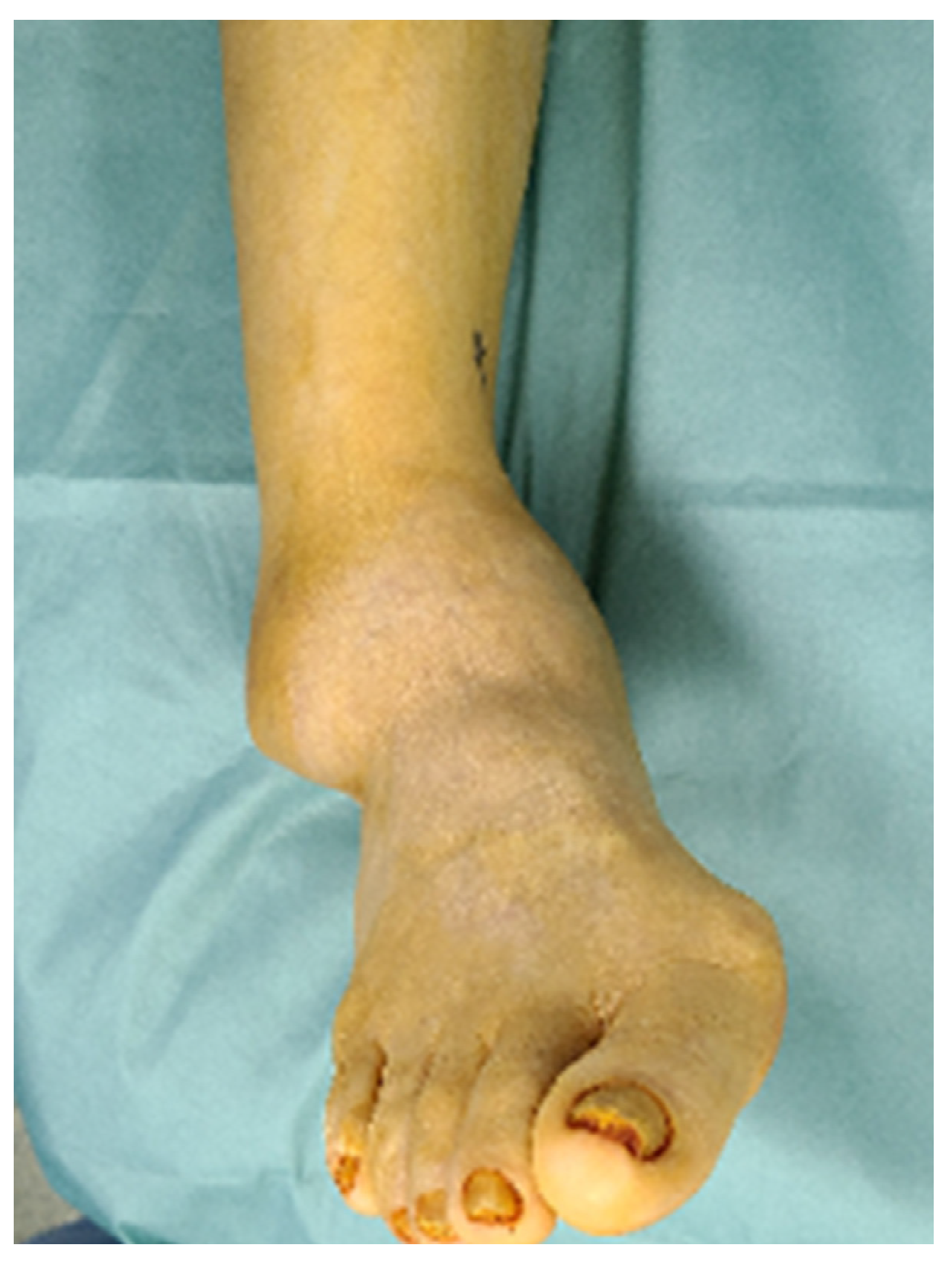


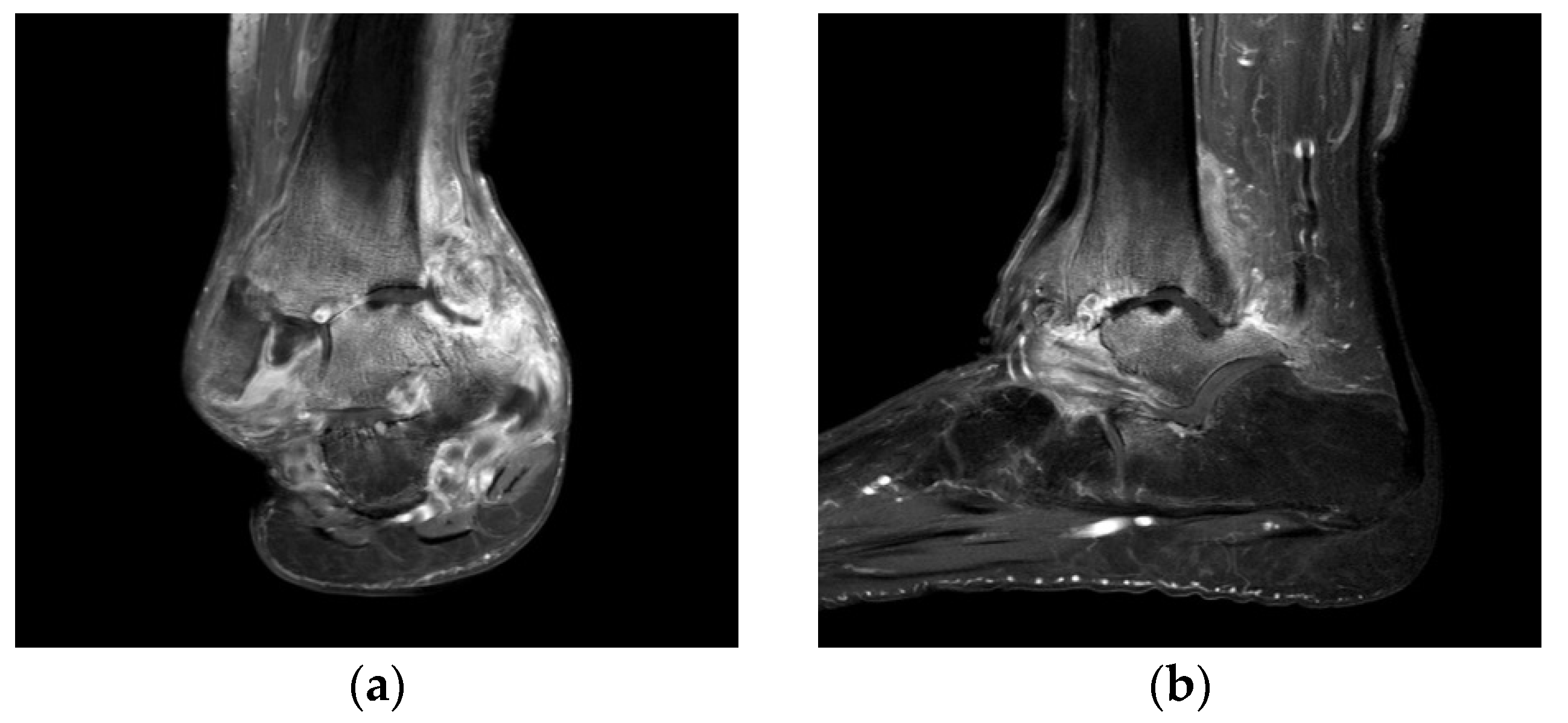

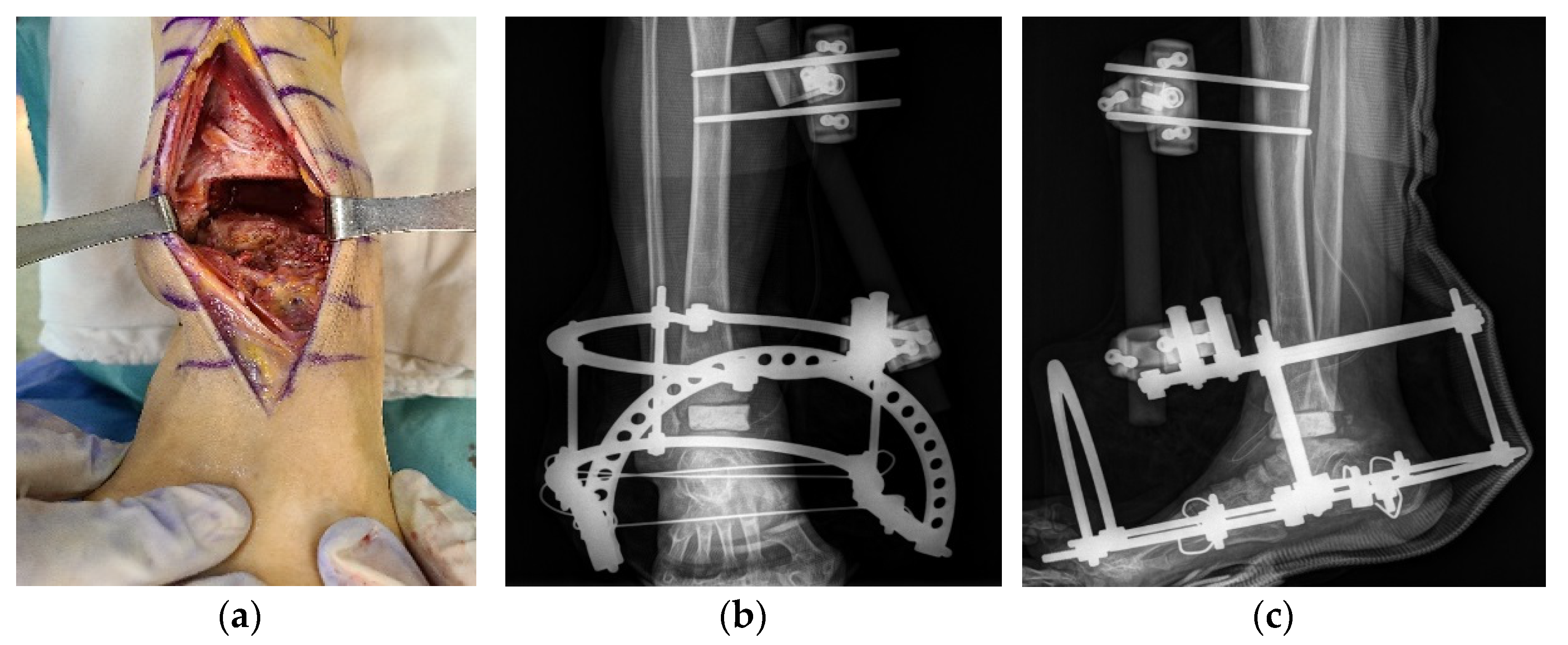
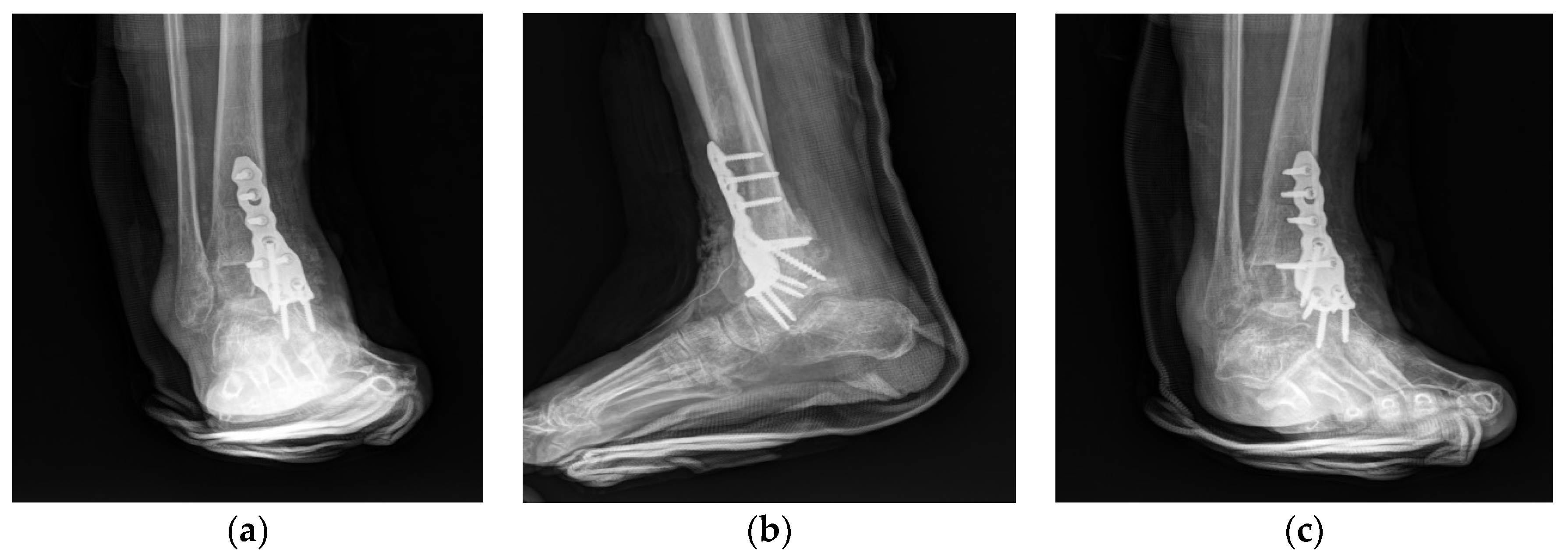
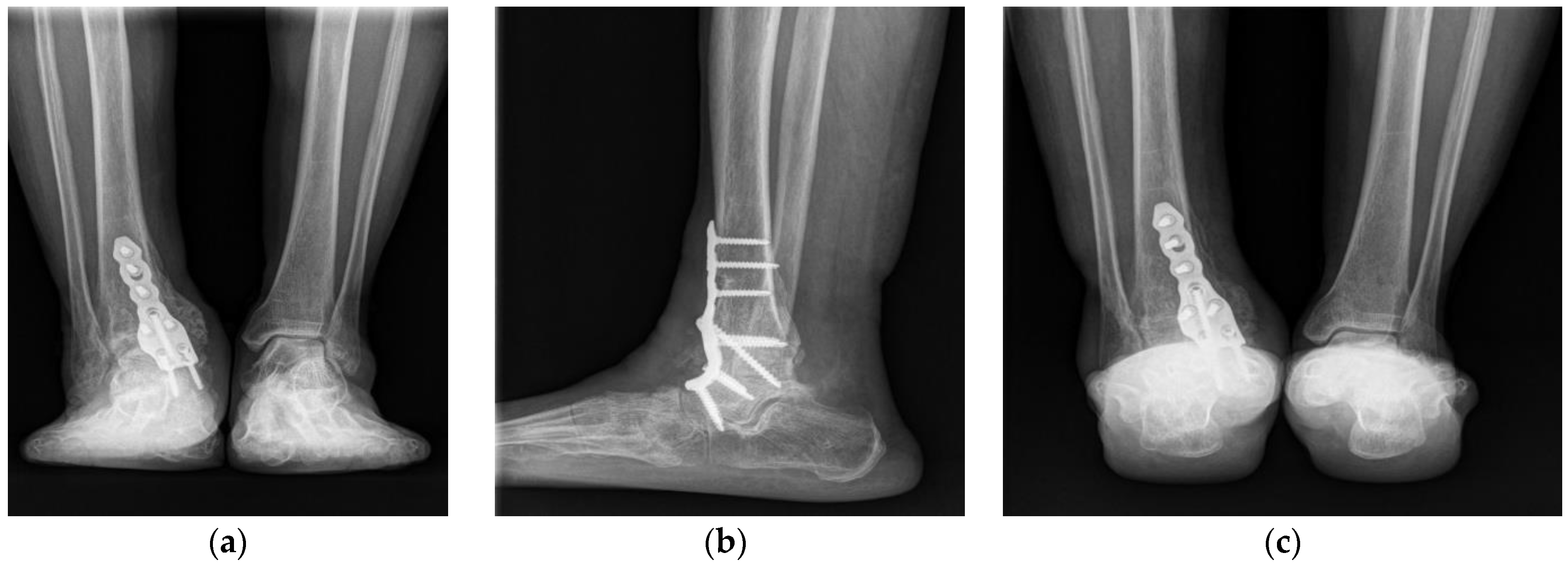
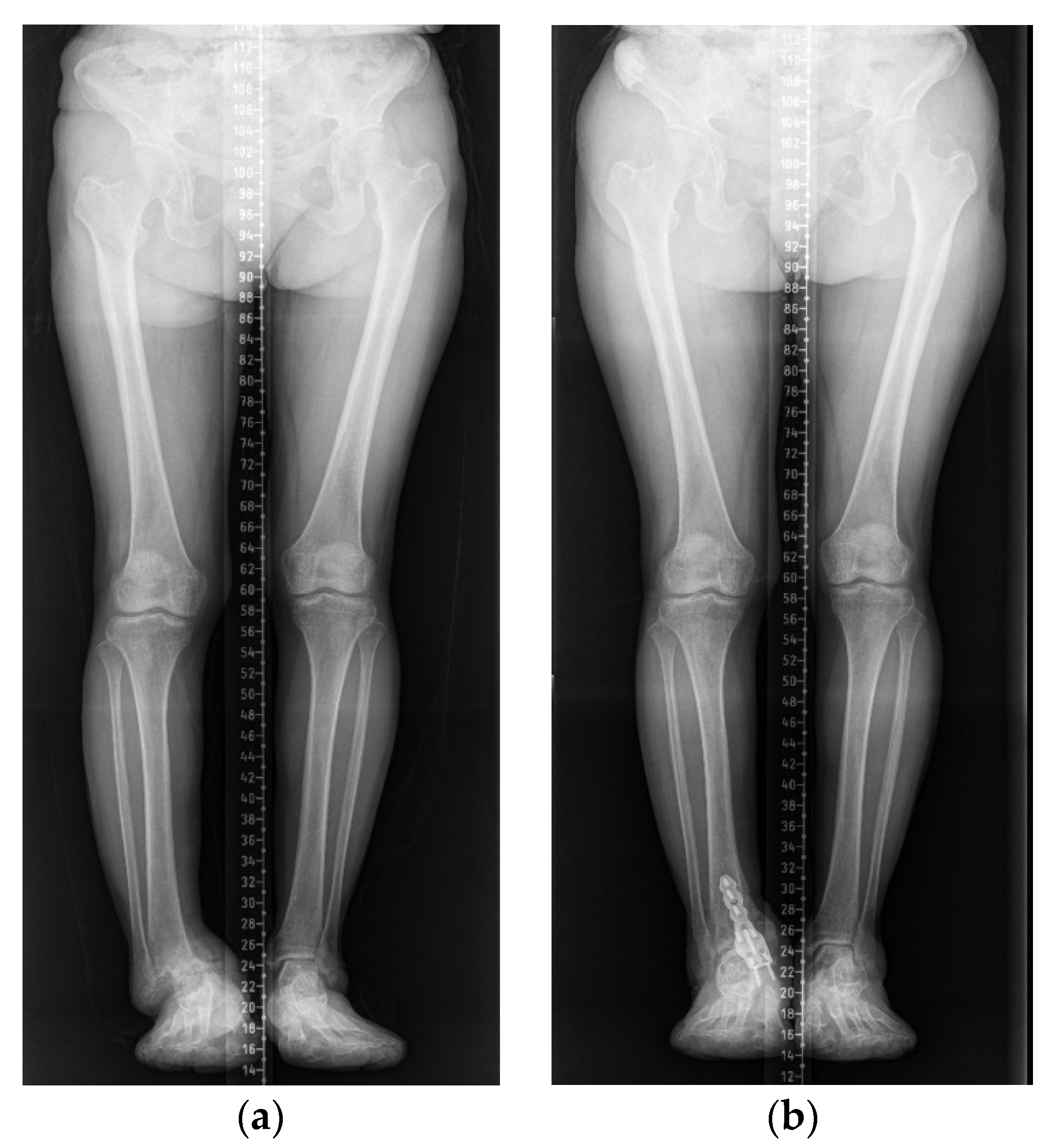
Publisher’s Note: MDPI stays neutral with regard to jurisdictional claims in published maps and institutional affiliations. |
© 2021 by the authors. Licensee MDPI, Basel, Switzerland. This article is an open access article distributed under the terms and conditions of the Creative Commons Attribution (CC BY) license (https://creativecommons.org/licenses/by/4.0/).
Share and Cite
Hong, Y.-C.; Jung, K.-J.; Chang, H.-J.; Yeo, E.-D.; Lee, H.-S.; Won, S.-H.; Ji, J.-Y.; Lee, D.-W.; Yoo, I.-D.; Yoon, S.-J.; et al. Staged Joint Arthrodesis in the Treatment of Severe Septic Ankle Arthritis Sequelae: A Case Report. Int. J. Environ. Res. Public Health 2021, 18, 12473. https://doi.org/10.3390/ijerph182312473
Hong Y-C, Jung K-J, Chang H-J, Yeo E-D, Lee H-S, Won S-H, Ji J-Y, Lee D-W, Yoo I-D, Yoon S-J, et al. Staged Joint Arthrodesis in the Treatment of Severe Septic Ankle Arthritis Sequelae: A Case Report. International Journal of Environmental Research and Public Health. 2021; 18(23):12473. https://doi.org/10.3390/ijerph182312473
Chicago/Turabian StyleHong, Yong-Cheol, Ki-Jin Jung, Hee-Jun Chang, Eui-Dong Yeo, Hong-Seop Lee, Sung-Hun Won, Jae-Young Ji, Dhong-Won Lee, Ik-Dong Yoo, Sung-Joon Yoon, and et al. 2021. "Staged Joint Arthrodesis in the Treatment of Severe Septic Ankle Arthritis Sequelae: A Case Report" International Journal of Environmental Research and Public Health 18, no. 23: 12473. https://doi.org/10.3390/ijerph182312473
APA StyleHong, Y.-C., Jung, K.-J., Chang, H.-J., Yeo, E.-D., Lee, H.-S., Won, S.-H., Ji, J.-Y., Lee, D.-W., Yoo, I.-D., Yoon, S.-J., & Kim, W.-J. (2021). Staged Joint Arthrodesis in the Treatment of Severe Septic Ankle Arthritis Sequelae: A Case Report. International Journal of Environmental Research and Public Health, 18(23), 12473. https://doi.org/10.3390/ijerph182312473






